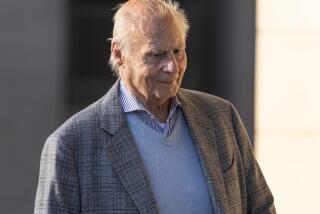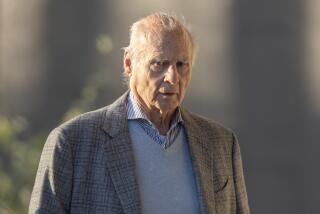Mayorâs Trial Turns Into War of Numbers in Key Issue Conflict
A local accounting professor testified Wednesday that Tom Shepard & Associates lost more than $130,000 by running San Diego Mayor Roger Hedgecockâs 1983 campaign--a claim that Hedgecock dismissed as âa complete fraudâ based on a âbiased, selectiveâ analysis of the political consultantâs financial records.
During a daylong war of numbers, attorneys in Hedgecockâs felony retrial battled over one of the central issues in the case: the question of whether Shepardâs consulting firm was, as the prosecution contends, essentially a political laundering service used to funnel illegal contributions to Hedgecockâs campaign, or whether, as the defense argues, it was a legitimate business willing to absorb a financial loss to enhance its reputation by running a successful citywide campaign.
Arthur Brodshatzer, a San Diego State University professor and certified public accountant who testified during Hedgecockâs first trial, was on the witness stand for more than three hours Wednesday, seeking to lead the eight-woman, four-man jury through a maze of numbers and financial transactions that prosecutors contend document how Hedgecock allegedly conspired with three of his prominent backers to use Shepardâs firm as a pipeline for illegal donations to the mayorâs 1983 race.
In a lengthy, often confusing and occasionally comic test of wills, the opposing attorneys consistently used the same set of facts but diametrically opposed theories and interpretations in their questioning in an attempt to direct Brodshatzerâs testimony into areas most favorable to their respective positions.
By dayâs end, both sides believed that they had scored key points with the jury, including disclosures or contentions that:
- Shepardâs firm lost between $137,887 and $157,386, âand probably more,â while coordinating Hedgecockâs campaign from August, 1982, through May, 1983, according to Brodshatzer. However, in addition to vigorously disputing the validity of the accountantâs theory, defense attorney Michael Pancer also got Brodshatzer to concede that Shepardâs firm conceivably could have used the Hedgecock campaign as a âloss leaderâ designed to attract other clients.
- Former J. David & Co. principal Nancy Hoover purportedly received tax deductions in excess of $100,000 for investments that she and J. David founder J. David (Jerry) Dominelli made in Tom Shepard & Associates throughout 1982 and 1983. Pancerâs attempt to introduce into evidence a tax form documenting Hooverâs deductions touched off a heated debate with Deputy Dist. Atty. Charles Wickersham, who accused the defense attorney of âtrial by trickeryâ and blocked, at least temporarily, the tax formâs acceptance by Superior Court Judge William L. Todd Jr.
- Hoover contributed $250 to Hedgecock, the maximum individual donation allowed under local election laws, in June, 1981--a revelation that raises questions about one of the major underpinnings of the prosecutionâs case. One of the cornerstones of the alleged conspiracy, prosecutors contend, was a crucial November, 1981, luncheon at which Hedgecock reportedly agreed to reconcile with Hoover and cease criticizing her for leaving her husband to live with Dominelli. Noting that Hooverâs $250 contribution preceded that luncheon by more than five months, Hedgecock concluded, âSo much for the reconciliation theory.â
Most of Wednesdayâs court session was devoted to a verbal and statistical joust between Pancer and Brodshatzer, who was paid $175 per hour by the district attorneyâs office as an âexpert witness.â (Pancer, who represented Hedgecock in the mayorâs first trial, is serving as co-counsel to chief defense attorney Oscar Goodman in the retrial.)
During his cross-examination, Pancer relentlessly chipped away at the accounting professorâs assertion that Shepardâs firm lost about 39 cents on every dollar that it spent on Hedgecockâs behalf, compared to a 31-cent profit on every dollar that the firm received from other clients. However, Brodshatzer, who seemed to relish the verbal give-and-take with Pancer, just as tenaciously sought to hold his ground by defending his analyses of the Hedgecock campaignâs and Shepard firmâs finances.
Between August, 1982, and May, 1983--the month in which Hedgecock won a special mayoral race to succeed Pete Wilson after the latterâs election to the U.S. Senate --Shepardâs firm received $352,247 from Hedgecockâs campaign committee and paid $337,568 in campaign-related bills, Brodshatzer testified.
While those figures produce a $14,679 surplus, one of Brodshatzerâs major conclusions is that if a pro-rated portion of Tom Shepard & Associatesâ staff expenses, overhead and operating costs had been charged to the Hedgecock campaign, the firm actually âlostâ between $137,887 and $157,386, depending on the accounting method used.
The defense contends that the question of whether Shepardâs firm made a profit or lost money on the campaign is irrelevant. The essence of their argument is that Hedgecockâs campaign committee had a valid, market-rate contract with Shepardâs firm; whether the resulting fee was large enough to produce a profit was Shepardâs concern, not Hedgecockâs, they say.
âAll the bills sent by (Shepardâs firm). . . to the Roger Hedgecock for Mayor Committee were paid, werenât they?â Pancer asked.
âTo the best of my knowledge, yes,â Brodshatzer answered.
Initially paid a $750 monthly retainer by Hedgecockâs campaign, Shepardâs firm later received a 15% commission on all electronic media advertisements bought on Hedgecockâs behalf--a formula that produced a fee of $30,150 throughout the mayoral race. Brodshatzer, however, contended that Hedgecockâs campaign actually paid only $14,679, less than half of that amount required under the contract.
In addition, the accountant asserted that Shepard could have easily anticipated that the contract with Hedgecockâs campaign would generate huge financial losses for his firm.
âThe contract . . . doesnât even cover two months of (Shepardâs) payroll,â Brodshatzer said. âIt was a guaranteed loss from the beginning.â
However, one of the overriding arguments advanced by Pancer and Hedgecock is that Shepard realized that running a successful mayoral campaign would enhance his fledging firm, founded in January, 1982, and act as a magnet for new clients--which, in fact, proved to be the case.
In a replay of scenes from the first trial, Pancer, after repeatedly asking questions focused on that âloss leaderâ theory, finally won a grudging concession from Brodshatzer that such long-range goals would be âone of the things Iâd considerâ in making the kind of decision Shepard did in regard to Hedgecockâs campaign.
Pancer also criticized Brodshatzer for ending his financial analysis of Shepardâs firm in May, 1983, arguing that doing so distorted the picture of the firmâs financial status.
âHeâs taking a carefully sculpted time in a two-year history of a firm when thereâs the highest overhead and least income,â Hedgecock said. âIt shows the worst moment in the firmâs fiscal history.â As a result of Hedgecockâs 1983 victory, Shepardâs firm was âon its way to becoming profitable,â the mayor added. âI paid off as a âloss leader.â â
Pancerâs attempt to introduce evidence about Hooverâs tax deductions stemming from the more than $360,000 that she and Dominelli invested in Shepardâs firm touched off Wickershamâs most emotional response to date.
With jurors out of the courtroom, Pancer argued to Todd that Hooverâs tax documents had been introduced at the first trial, adding that they should be reintroduced under an agreement between the two sides not to oppose the introduction of documents admitted in the first trial.
âIâve never agreed to (accept) that!â Wickersham shouted. âThat document is too important. What it purports to show is pretty important to this case.â
What the document shows, Pancer argues, is that Hooverâs six-figure tax write-offs âeffectively cut her losses from her investment (in Shepardâs firm) in halfâ--a fact that the defense could use in its attempt to portray her investments as legitimate business decisions, not illegal campaign donations.
âThatâs why they donât want it (the documents) in,â Pancer said.
However, transcripts from the first trial--read by court officials at Toddâs request--showed that the prosecution had objected to the tax formsâ introduction in the first trial. Because of the lack of mutual consent, Todd refused to allow Pancer to introduce the document as evidence Wednesday. The defense, however, hopes to resurrect the document when it presents its side of the case later in the trial.
More to Read
Sign up for Essential California
The most important California stories and recommendations in your inbox every morning.
You may occasionally receive promotional content from the Los Angeles Times.









